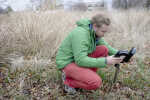Students tell visual stories in photography course

LINCOLN, Nebraska -- Students in a course at the University of Nebraska-Lincoln are learning that a story does not have to be words on a page.
Digital Imaging and Storytelling offers students an opportunity to work with high quality photography equipment to document the world around them. With time-lapse photography and video, the students developed their ability to tell stories visually.
Peter Stegen, a senior fisheries and wildlife major from Austin, Minn., focused on decomposition. Stegen said while most people don't like to think about death and decomposition, he has always been fascinated by the subject.
"Visually, the process of decomposition is rarely put in a beautiful way," Stegen said. "I wanted to show decomposition as a beautiful reality, a necessary part of life."
He started gathering photos of a deer decomposing on East Campus in September. Using a time-lapse camera, Stegen collected photos that show the process over several months and has edited that footage into a project for the course.
The class grew out of the Platte River Basin Time-lapse Project and is taught by two of that project's leaders, Michael Farrell from NET Television and photographer Michael Forsberg. Farrell said the class gives students the freedom to experiment with new ways to tell stories.
"When you start in the work force, you don't get to pick what you work on," he said. "But with this, they can generate their own ideas and follow them through."
When the course began last fall, the instructors saw that the students needed time to familiarize themselves with the sophisticated equipment, including time-lapse cameras and traps for the cameras. The class has since been extended into a variable length class, allowing students more time to complete their stories.
"If you want to tell a story, you have to have the time to gather the material," Farrell said.
Every student from last fall returned for a second semester to continue working on their project. Two new students joined the group when the new semester arrived in January.
Emma Likens, a sophomore agricultural journalism major from Swanton, is one of four students, including Stegen, who has taken advantage of an additional semester to finish her project on her aunt and uncle's dairy farm near Fairbury. She set out to show how the farm, Fairley Dairy, was affected by last year's drought, but this proved challenging to demonstrate visually.
"You can show the sun moving over the field, but you can't see how it affects the farm," Likens said.
She adjusted to this by focusing on a written article about the past, present and future of the farm. It will eventually be published online in a blog format with video clips and time-lapse photography. Likens said that she enjoyed following her aunt and uncle around with a camera.
"I thought I knew about the dairy industry, but I've learned a lot," she said.
All of the students also learned about the advanced photography equipment they have used throughout their projects. Likens read photography blogs to help get accustomed to the cameras. Stegen also said he had to take time to familiarize himself with the equipment.
"I can have the nicest camera money can buy, but if I don't know how to use it, then what good will it do me?" he said. "You have to be prepared for things to fail, because they do, often."
Farrell said this challenges students to develop their skills with the technology, but also to wait for the story to come together.
"You burn up a lot of time waiting for things to unfold. You have to leave it open ended to find the best way to tell the story."
